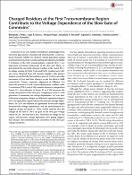About a decade ago, the molecular determinants controlling the opening and closing of Cx43 gap junction channels have been identified. Advanced biophysical approaches revealed a critical role for structural rearrangements in the cytoplasmic loop and dimerization of the C-terminal tail, resulting ...
Selecciona los documentos para visualizarlos
| Nombre del archivo | Ver recurso |
|---|











